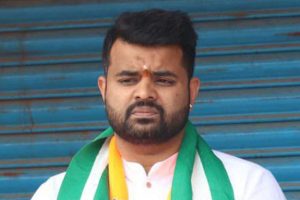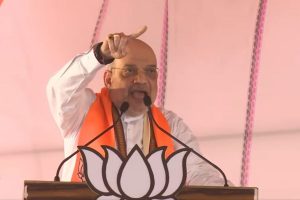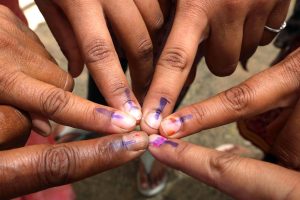With the Indian Prime Minister Narendra Modi’s US visit in progress, most Indian Americans are in a celebratory mood in welcoming him and praising him for major improvements in both economy and peace in India during his tenure. However, there are others who are urging us not to forget his “dark” history of Hindu nationalism and treatment of minorities, especially the Muslims and Christians as second-class citizens.
I do not know if Mr. Modi will promote Hinduism during his visit, apart from holding a yoga session at the UN and perhaps even initiate a religious division among the Indian Americans. It is interesting to note that although Swami Vivekananda delivered his famous lecture in Chicago in 1893 there is no large-scale organized effort to promote Hinduism in the USA in a philosophical or religious sense. Gone are the Hare Krishna crowd of the hippie era and transcendental meditation of Mahesh Yogi. Scandals of gurus like Sri Rajnish probably did not help the cause. However, there is a hunger for eastern spiritualism among many Americans. Organizations such as the Vedanta Society, Krishna Consciousness, Ramkrishna Mission and Bharat Sevashram Sangha have massive followings among the Indian American communities but are virtually unknown to mainstream American society.
The first-generation Indians who immigrated to this country in the 1960s and 70s are now devoting their time and financial resources to religious activities – most notably construction of temples for worship and religious gatherings. Apart from providing a convenient outlet to keep the senior citizens of the community occupied, such activities serve several purposes.
They promote and preserve our cultural and religious traditions for future generations. The facilities provide a convenient venue for various social gatherings and ceremonies. They add a novel structure to the local cityscape. However, non-Indians are almost never seen in these festivities; the ones who do attend are typically related to some Indian member involved in the activities. There are several reasons for this apparent self-exclusion by the westerners:
a) the events are usually not publicized in the media and only the Indians find out by word of mouth, email, “desi” newsletters and leaflets;
b) they probably feel some barriers (such as dress code, language, food) even if they want to attend;
c) presentations generously use difficult languages from scriptures which are not easy to follow, and
d) there is a disconnect between the everyday experience of common people and what the speaker preaches. By contrast, when a pastor recites a verse from the Bible during Sunday sermon at a church, he tries to relate it to our daily experiences. In addition, the Indians themselves do not feel any urge to invite non-Indian friends or neighbours to their religious occasions.
Unlike the Christians, Indians are remarkably passive about spreading a good word about their religions. Most of us identify ourselves by the religion of our parents. We typically do not practice regular routines like daily prayer or visiting temples on certain days. In addition, since most of us are educated in technical subjects, many tend to be non-believers in divine interventions which cannot be proved by scientific theories.
I believe that it is important to promote Hinduism in this country for two main reasons. It would help the Indian immigrants to be accepted by and get assimilated into American society better because their value system and philosophical mindset would be better understood.
Many false impressions about Hinduism would also be clarified and “Hinduphobia” be minimized. This is especially important now because the Indian diaspora constitutes the second largest group of immigrants in the US (after Mexicans) and most of them are Hindus. Secondly for the spiritually starved Americans it is an alternative source to seek answers to their eternal spiritual questions and find peace in a highly materialistic and conflicted world they live in. The ashrams, established by various gurus and their activities used to be the main tool in spreading Hinduism.
Although there are still dozens of ashrams and retreats all over the USA most are now commercialized, for example promoting weekend getaway packages involving meditation, yoga classes, lectures, massages etc.
The only one which is universally known and has been in existence for many decades is the Self Realization Fellowship (SRF) established by Paramhansa Yogananda in 1920. Several aspects of the SRF ashrams are not only unique but highlight what is needed to make Eastern religions and not just Hinduism popular to the Americans.
First there is no emphasis on any religion or religious icon or any ritual. In their prayer halls, photographs of Christ, Krishna, Buddha, Lahiri Mahashay and others are all displayed on the same podium. Secondly there are extensive compounds where any visitor can wander around or meditate without any interference from anyone.
There is no pressure of any kind on visitors such as solicitation for donation or appeal to join the fellowship or asking for personal information. On top of that the locations of the ashrams are very scenic and serene. Just the environments themselves can put a person in a spiritual introspective mode. Unfortunately, almost all their temples are in California.
I knew the name Yogananda because of my father’s association with him in Yogoda Sat Sang – the original Indian version of SRF. Coincidentally I ended up working and living in the San Diego area many years later where I discovered the SRF ashram in Encinitas (a suburb of San Diego) almost by accident. I was not a religious person but my first visit to that SRF facility had a profound impact on me.
I did not attend any religious offerings there, just walked around the compound and felt a divine connection. I bought the book “An Autobiography of a Yogi” by Yogananda from their bookstore because my father mentioned this book many times during my childhood. In Chapter 43 of this book, Yogananda gives a detailed account of what Sri Yukteswar told him during a resurrection about what happens after death. I found answers to many of my eternal questions. The chapter is the essence of the teachings of Hinduism.
I can say without any religious bias that when it comes to life, death, universe and God the Hindu holy men had said it all thousands of years ago. All the subsequent religions just rehashed them in various ways. I believe that the SRF organization is a good model to emulate if one wants to make more people aware of our great religions. In fact, Yogananda was sent by his guru to the USA with the explicit purpose of teaching the practice of kriya yoga to the Americans. Most of his guiding principles are simple and direct, tailored towards an American audience with an American lifestyle.
Some are available on YouTube. I hope that Mr. Modi does talk about Hinduism and the fact that it is the “sanatan dharma” (eternal religion). Whether we follow the SRF model or not, we, the Hindu Americans, can start spreading the word by taking some simple steps.
i) Lobby to include books on spirituality in all local libraries; we can donate such books to the libraries ourselves.
ii) Suggest to the local community colleges to include such books in a college curriculum on theology.
iii) Plan and advertise events with the goal of attracting non-Hindu attendees. Such events should include lectures, movies, sharing of personal stories, book selling etc.
iv) Use social media more effectively. If just reading one chapter of a book can spiritually transform someone as non-religious “American” as me, I am optimistic that a similar transformation of a broader segment of the American population is certainly possible.
(The writer, a physicist who worked in industry and academia, is a Bengali settled in America.)











